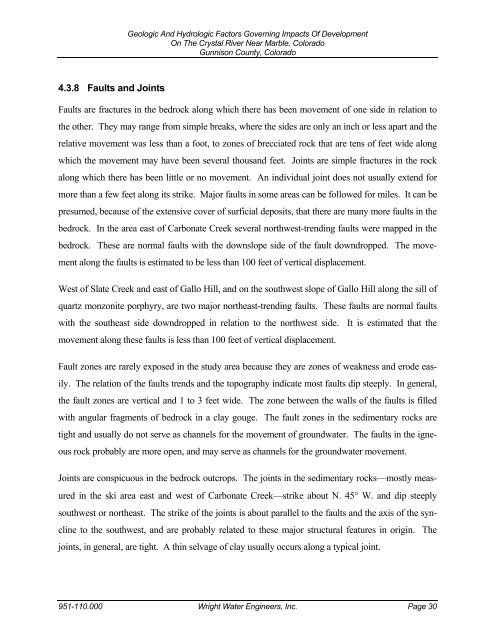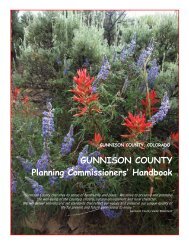Geologic And Hydrologic Factors Governing ... - Gunnison County
Geologic And Hydrologic Factors Governing ... - Gunnison County
Geologic And Hydrologic Factors Governing ... - Gunnison County
You also want an ePaper? Increase the reach of your titles
YUMPU automatically turns print PDFs into web optimized ePapers that Google loves.
4.3.8 Faults and Joints<br />
<strong>Geologic</strong> <strong>And</strong> <strong>Hydrologic</strong> <strong>Factors</strong> <strong>Governing</strong> Impacts Of Development<br />
On The Crystal River Near Marble, Colorado<br />
<strong>Gunnison</strong> <strong>County</strong>, Colorado<br />
Faults are fractures in the bedrock along which there has been movement of one side in relation to<br />
the other. They may range from simple breaks, where the sides are only an inch or less apart and the<br />
relative movement was less than a foot, to zones of brecciated rock that are tens of feet wide along<br />
which the movement may have been several thousand feet. Joints are simple fractures in the rock<br />
along which there has been little or no movement. An individual joint does not usually extend for<br />
more than a few feet along its strike. Major faults in some areas can be followed for miles. It can be<br />
presumed, because of the extensive cover of surficial deposits, that there are many more faults in the<br />
bedrock. In the area east of Carbonate Creek several northwest-trending faults were mapped in the<br />
bedrock. These are normal faults with the downslope side of the fault downdropped. The move-<br />
ment along the faults is estimated to be less than 100 feet of vertical displacement.<br />
West of Slate Creek and east of Gallo Hill, and on the southwest slope of Gallo Hill along the sill of<br />
quartz monzonite porphyry, are two major northeast-trending faults. These faults are normal faults<br />
with the southeast side downdropped in relation to the northwest side. It is estimated that the<br />
movement along these faults is less than 100 feet of vertical displacement.<br />
Fault zones are rarely exposed in the study area because they are zones of weakness and erode eas-<br />
ily. The relation of the faults trends and the topography indicate most faults dip steeply. In general,<br />
the fault zones are vertical and 1 to 3 feet wide. The zone between the walls of the faults is filled<br />
with angular fragments of bedrock in a clay gouge. The fault zones in the sedimentary rocks are<br />
tight and usually do not serve as channels for the movement of groundwater. The faults in the igne-<br />
ous rock probably are more open, and may serve as channels for the groundwater movement.<br />
Joints are conspicuous in the bedrock outcrops. The joints in the sedimentary rocks—mostly meas-<br />
ured in the ski area east and west of Carbonate Creek—strike about N. 45° W. and dip steeply<br />
southwest or northeast. The strike of the joints is about parallel to the faults and the axis of the syn-<br />
cline to the southwest, and are probably related to these major structural features in origin. The<br />
joints, in general, are tight. A thin selvage of clay usually occurs along a typical joint.<br />
951-110.000 Wright Water Engineers, Inc. Page 30



